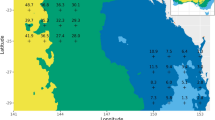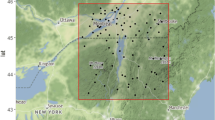Abstract
The North American multi-model ensemble (NMME) forecast system provides valuable information for climate variables at different lead times over the globe. A Bayesian ensemble post-processing approach based on Copula functions (COP-EPP) is employed to bias-correct the NMME precipitation forecast from 11 models (totaling 128 ensemble members). The study is conducted over the Continental United States (CONUS) for the hindcast period of 1982–2010 at lead-0, and the forecast period of 2012–2015 at four different lead times of lead-0 to lead-3 and the results are verified using deterministic and probabilistic measures. COP-EPP is compared with a widely-used bias-correction technique, the Quantile Mapping (QM). Although the NMME forecasts show to be more accurate across the eastern United States, large bias is found over the great plains of the central US. However, QM and COP-EPP present significant improvements over the NMME forecasts, with COP-EPP proving to be more reliable and accurate across the CONUS. In addition, COP-EPP substantially improves the temporal and spatial variability of the intra-seasonal NMME forecasts, even at lead-3.









Similar content being viewed by others
References
Ahmadalipour A, Moradkhani H, Svoboda M (2016) Centennial drought outlook over the CONUS using NASA-NEX downscaled climate ensemble. Int J Climatol. doi:10.1002/joc.4859
Ahmadalipour A, Moradkhani H, Rana A (2017a) Accounting for downscaling and model uncertainty in fine-resolution seasonal climate projections over the Columbia River Basin. Clim Dyn. doi:10.1007/s00382-017-3639-4
Ahmadalipour A, Moradkhani H, Yan H, Zarekarizi M (2017b) Remote sensing of drought: vegetation, soil moisture and data assimilation. Remote sensing of hydrological extremes. Springer International Publishing Switzerland, pp 121–149
Ahmadalipour A, Moradkhani H, Demirel M (2017c) A comparative assessment of projected meteorological and hydrological droughts: elucidating the role of temperature. J Hydrol 553:785–797. doi:10.1016/j.jhydrol.2017.08.047
Aho K, Derryberry D, Peterson T (2014) Model selection for ecologists: the worldviews of AIC and BIC. Ecology 95:631–636
Anderson JL (2001) An ensemble adjustment Kalman filter for data assimilation. Mon Weather Rev 129:2884–2903
Barnston AG, Lyon B (2016) Does the NMME capture a recent decadal shift toward increasing drought occurrence in the southwestern United States? J Clim 29:561–581. doi:10.1175/JCLI-D-15-0311.1
Barnston AG, Tippett MK, van den Dool HM, Unger DA (2015) Toward an improved multimodel ENSO prediction. J Appl Meteorol Climatol 54:1579–1595
Becker E, van den Dool H (2015) Probabilistic seasonal forecasts in the North American Multi-Model Ensemble: a baseline skill assessment. J Clim 151210144222001. doi:10.1175/JCLI-D-14-00862.1
Becker E, den Dool H, Van Zhang Q (2014) Predictability and forecast skill in NMME. J Clim 27:5891–5906. doi:10.1175/JCLI-D-13-00597.1
Clark MP, Slater AG (2006) Probabilistic quantitative precipitation estimation in complex terrain. J Hydrometeor 7:3–22
Clark M, Gangopadhyay S, Hay L et al (2004) The Schaake shuffle: A method for reconstructing space-time variability in forecasted precipitation and temperature fields. J Hydrometeorol 5:243–262
DeWitt DG (2005) Retrospective forecasts of interannual sea surface temperature anomalies from 1982 to present using a directly coupled atmosphere-ocean general circulation model. Mon Weather Rev 133:2972–2995
Ehsan MA, Tippett MK, Almazroui M, Ismail M, Yousef A, Kucharski F, Omar M, Hussein M, Alkhalaf AA (2017) Skill and predictability in multimodel ensemble forecasts for Northern Hemisphere regions with dominant winter precipitation. Clim Dyn 48(9–10):3309–3324
Favre AC, El Adlouni S, Perreault L, Thiémonge N, Bobée B (2004) Multivariate hydrological frequency analysis using copulas. Water Resour Res 40(1). doi:10.1029/2003WR002456
Ficklin DL, Abatzoglou JT, Robeson SM, Dufficy A (2016) The influence of climate model biases on projections of aridity and drought. J Clim 29(4):1269–1285
Genest C, Rémillard B, Beaudoin D (2009) Goodness-of-fit tests for copulas: A review and a power study. Insur Math Econ 44:199–213
Hersbach H (2000) Decomposition of the continuous ranked probability score for ensemble prediction systems. Weather Forecast 15:559–570. doi:10.1175/1520-0434(2000)015<0559:DOTCRP>2.0.CO;2
Infanti JM, Kirtman BP (2014) Southeastern US rainfall prediction in the North American multi-model ensemble. J Hydrometeorol 15:529–550
Kavetski D, Kuczera G, Franks SW (2006) Bayesian analysis of input uncertainty in hydrological modeling: 2. Application. Water Resour Res 42(3). doi:10.1029/2005WR004376
Khajehei S, Moradkhani H (2017) Towards an improved ensemble precipitation forecast: a probabilistic post-processing approach. J Hydrol 546:476–489
Kirtman BP, Min D (2009) Multimodel ensemble ENSO prediction with CCSM and CFS. Mon Weather Rev 137(9):2908–2930
Kirtman BP, Min D, Infanti JM et al (2014) The North American multimodel ensemble: phase-1 seasonal-to-interannual prediction; phase-2 toward developing intraseasonal prediction. Bull Am Meteorol Soc 95:585–601
Lang Y, Ye A, Gong W et al (2014) Evaluating skill of seasonal precipitation and temperature predictions of NCEP CFSv2 forecasts over 17 hydroclimatic regions in China. J Hydrometeorol 15:1546–1559
Li H, Sheffield J, Wood EF (2010) Bias correction of monthly precipitation and temperature fields from Intergovernmental Panel on Climate Change AR4 models using equidistant quantile matching. J Geophys Res Atmos 115(D10). doi:10.1029/2009JD012882
Ma F, Ye A, Deng X et al (2016) Evaluating the skill of NMME seasonal precipitation ensemble predictions for 17 hydroclimatic regions in continental China. Int J Climatol 36:132–144. doi:10.1002/joc.4333
Madadgar S, Moradkhani H (2014) Spatio-temporal drought forecasting within Bayesian networks. J Hydrol 512:134–146. doi:10.1016/j.jhydrol.2014.02.039
Madadgar S, Moradkhani H, Garen D (2014) Towards improved post-processing of hydrologic forecast ensembles. Hydrol Process 28:104–122. doi:10.1002/hyp.9562
Madadgar S, AghaKouchak A, Shukla S, Wood AW, Cheng L, Hsu KL, Svoboda M (2016) A hybrid statistical-dynamical framework for meteorological drought prediction: application to the southwestern United States. Water Resour Res 52(7):5095–5110
Maurer EP, Ficklin DL, Wang W (2016) Technical Note: The impact of spatial scale in bias correction of climate model output for hydrologic impact studies. Hydrol Earth Syst Sci 20:685–696. doi:10.5194/hess-20-685-2016
Mehrotra R, Sharma A (2015) Correcting for systematic biases in multiple raw GCM variables across a range of timescales. J Hydrol 520:214–223
Merryfield WJ, Lee W-S, Boer GJ et al (2013) The Canadian seasonal to interannual prediction system. Part I: models and initialization. Mon Weather Rev 141:2910–2945
Miao C, Su L, Sun Q, Duan Q (2016) A nonstationary bias-correction technique to remove bias in GCM simulations. J Geophys Res Atmos 121(10):5718–5735
Mizukami N, Clark MP, Gutmann ED et al (2016) Implications of the methodological choices for hydrologic portrayals of climate change over the contiguous United States: statistically downscaled forcing data and hydrologic models. J Hydrometeorol 17:73–98
Mo KC, Lettenmaier DP (2014) Hydrologic prediction over the conterminous United States using the national multi-model ensemble. J Hydrometeorol 15:1457–1472
Mo KC, Lyon B (2015) Global meteorological drought prediction using the North American multi-model ensemble. J Hydrometeorol 16:1409–1424
Najafi MR, Moradkhani H (2015) Ensemble combination of seasonal streamflow forecasts. J Hydrol Eng 21:4015043
Najafi MR, Moradkhani H, Jung IW (2011) Assessing the uncertainties of hydrologic model selection in climate change impact studies. Hydrol Process 25:2814–2826. doi:10.1002/hyp.8043
New M, Hulme M, Jones P (1999) Representing twentieth-century space-time climate variability. Part I: development of a 1961–90 mean monthly terrestrial climatology. J Clim 12:829–856
Ozga-Zielinski B, Ciupak M, Adamowski J, Khalil B, Malard J (2016) Snow-melt flood frequency analysis by means of copula based 2D probability distributions for the Narew River in Poland. J Hydrol 6:26–51
Peterson TC, Heim RR, Hirsch R et al (2013) Monitoring and understanding changes in heat waves, cold waves, floods, and droughts in the United States: state of knowledge. Bull Am Meteorol Soc 94:821–834. doi:10.1175/BAMS-D-12-00066.1
Piani C, Haerter JO, Coppola E (2010) Statistical bias correction for daily precipitation in regional climate models over Europe. Theor Appl Climatol 99:187–192
Pierce DW, Cayan DR, Maurer EP et al (2015) Improved bias correction techniques for hydrological simulations of climate change. J Hydrometeorol. doi:10.1175/JHM-D-14-0236.1
Rana A, Moradkhani H, Qin Y (2017) Understanding the joint behavior of temperature and precipitation for climate change impact studies. Theor Appl Climatol 129(1–2):321–339
Renard B, Kavetski D, Kuczera G, Thyer M, Franks SW (2010) Understanding predictive uncertainty in hydrologic modeling: the challenge of identifying input and structural errors. Water Resour Res 46(5). doi:10.1029/2009WR008328
Roulin E, Vannitsem S (2015) Post-processing of medium-range probabilistic hydrological forecasting: impact of forcing, initial conditions and model errors. Hydrol Process 29:1434–1449
Saha S, Moorthi S, Wu X et al (2014) The NCEP climate forecast system version 2. J Clim 27:2185–2208
Schaake J, Demargne J, Hartman R et al (2007) Precipitation and temperature ensemble forecasts from single-value forecasts. Hydrol Earth Syst Sci Discuss 4:655–717. doi:10.5194/hessd-4-655-2007
Schneider U, Becker A, Finger P et al (2011) GPCC full data reanalysis version 6.0 at 0.5: monthly land-surface precipitation from rain-gauges built on GTS-based and historic data. doi:10.5676/DWD_GPCC
Schneider U, Becker A, Finger P et al (2014) GPCC’s new land surface precipitation climatology based on quality-controlled in situ data and its role in quantifying the global water cycle. Theor Appl Climatol 115:15–40
Shirvani A, Landman WA (2015) Seasonal precipitation forecast skill over Iran. Int J Climatol 1900:1887–1900. doi:10.1002/joc.4467
Shukla S, Roberts J, Hoell A et al (2016) Assessing North American multimodel ensemble (NMME) seasonal forecast skill to assist in the early warning of anomalous hydrometeorological events over East Africa. Clim Dyn. doi:10.1007/s00382-016-3296-z
Slater LJ, Villarini G, Bradley AA (2016) Evaluation of the skill of North-American multi-model ensemble (NMME) global climate models in predicting average and extreme precipitation and temperature over the continental USA. Clim Dyn 1–16. doi:10.1007/s00382-016-3286-1
Stephens MA (1974) EDF statistics for goodness of fit and some comparisons. J Am Stat Assoc 69:730–737
Tebaldi C, Knutti R (2007) The use of the multi-model ensemble in probabilistic climate projections. Philos Trans A Math Phys Eng Sci 365:2053–2075. doi:10.1098/rsta.2007.2076
Thober S, Kumar R, Sheffield J et al (2015) Seasonal Soil Moisture Drought Prediction over Europe using the North American Multi-Model Ensemble (NMME). J Hydrometeorol. doi:10.1175/JHM-D-15-0053.1
Tian D, Martinez CJ, Graham WD, Hwang S (2014) Statistical downscaling multimodel forecasts for seasonal precipitation and surface temperature over the southeastern United States. J Clim 27:8384–8411
Vecchi GA, Delworth T, Gudgel R et al (2014) On the seasonal forecasting of regional tropical cyclone activity. J Clim 27:7994–8016
Willmott CJ, Matsuura K, Legates DR (2001) Terrestrial air temperature and precipitation: monthly and annual time series (1950–1999) (version 1.02). Center for Climate Research, University of Delaware, Newark, DE
Xie P, Chen M, Shi W (2010) CPC unified gauge-based analysis of global daily precipitation. In: 24th Conference on Hydrology, Atlanta, GA, American Meteorological Society, vol 2
Yang Z, Hsu K, Sorooshian S, Xu X, Braithwaite D, Verbist KM (2016) Bias adjustment of satellite-based precipitation estimation using gauge observations: a case study in Chile. J Geophys Res Atmos 121(8):3790–3806
Yuan X, Wood EF (2013) Multimodel seasonal forecasting of global drought onset. Geophys Res Lett 40:4900–4905. doi:10.1002/grl.50949
Yuan X, Wood EF, Chaney NW et al (2013a) Probabilistic seasonal forecasting of African drought by dynamical models. J Hydrometeorol 14:1706–1720
Yuan X, Wood EF, Roundy JK, Pan M (2013b) CFSv2-based seasonal hydroclimatic forecasts over the conterminous United States. J Clim 26:4828–4847
Yuan X, Roundy JK, Wood EF, Sheffield J (2015) Seasonal forecasting of global hydrologic extremes : System development and evaluation over GEWEX basins. Bull Am Meteorol Soc 96:1895–1912. doi:10.1175/BAMS-D-14-00003.1
Zhang S, Harrison MJ, Rosati A, Wittenberg A (2007) System design and evaluation of coupled ensemble data assimilation for global oceanic climate studies. Mon Weather Rev 135:3541–3564
Acknowledgements
Partial financial support for this project was provided by the National Oceanic and Atmospheric Administration (NOAA) Modeling, Analysis, Predictions, and Projections (MAPP) (Grant No. NA140AR4310234).
Author information
Authors and Affiliations
Corresponding author
Electronic supplementary material
Below is the link to the electronic supplementary material.
Rights and permissions
About this article
Cite this article
Khajehei, S., Ahmadalipour, A. & Moradkhani, H. An effective post-processing of the North American multi-model ensemble (NMME) precipitation forecasts over the continental US. Clim Dyn 51, 457–472 (2018). https://doi.org/10.1007/s00382-017-3934-0
Received:
Accepted:
Published:
Issue Date:
DOI: https://doi.org/10.1007/s00382-017-3934-0




